I've been working on this emergent Space Element Reduction Duplication system for some time now, starting from a Masters dissertation into non-deterministic cellular automata, then a 2015 Wolfram Summer School research project, two published papers, one in the Journal of Cellular automata and the other in Complex systems to it's current form.
In this post I wish to share some diagrams that I made with an online diagram editor to demonstrate the general structure the system and the proposed update rules that act on the state graph.
It appears to have a number of characteristics similar to the wolfram model however it is more specific and has some constraints that I have found it difficult to recreate with the Wolfram Model functions. It is a graph data structure that evolves via a set of update operations on the elements, the order of which effects the output state through time and is a multi-way system as described in NKS, any overlap of update events forces the system into the next moment in time. There are causal relations between update events and both branchial and causal graphs could theoretically be made of this system.
Unlike the wolfram model where all information of the system is contained in the state graph, the SERD model allows for information to be stored on the nodes, this corresponds to a sort of 'awareness' of the elements of the perspective they have of the state at any instance in time corresponding to the information that they observer. Information of the state of the system that exist in the gaps between elements is transferred between nearest neighbours through time.
While some update operations may or may not be performed through one time step (such as duplication and reduction of space elements and splitting and merging of point particles (see below)), other operations are enforced to happen through each time step, such as information propagation, the update of information on point particles to determine the observed state of of the system from that point particles point of view, or the propagation of 'propagating structural bifurcations' which is essentially the information of a split being transported through the state graph. This along with the information stored on the gaps between elements of the state graph have proven difficult to reproduce with the Wolfram Model, however perhaps there maybe a way with which to do it ith some help. Please feel free to reach out if you think you can help with this.
I can definitely see a way that a reduced version of the system can be implemented using the Wolfram Model framework, however I may need some help with which to do it.
I've obtained some physically comparable results and have made my source code available. I have a number of physical comparisons within this system, and the fully emergent structure appears detailed and rich. I have published some of my research in peer reviewed literature, and I've recently published my source code and youtube videos explaining the system.
I want to know what the wolfram community think of the update rules that I am implementing and does anyone else see why these specific rules are of such interest to me and understand the emergence out of the philosophical first principle that I describe in my Mathematica notebook in my previous post https://community.wolfram.com/groups/-/m/t/2589079.
I'm quite happy for people to be critical and blunt. I don't have all the answers but the system ideally should speak for itself.
SERD Model: Update Rules
Thomas Wood
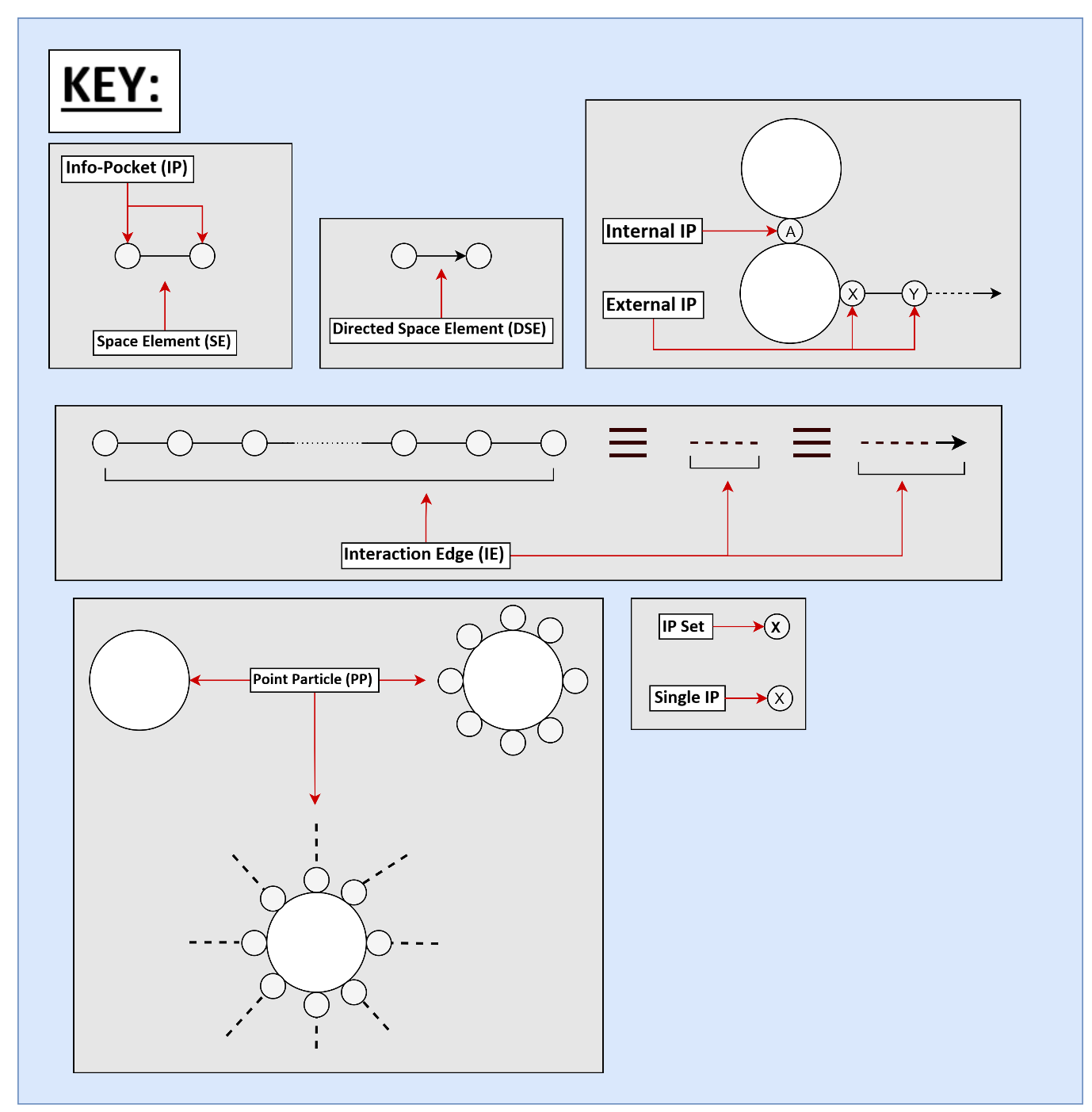
Space Element (SE) – Fundamental proportionate constituent of the system, generating the geometry of the system within the dimensions that they represent.
Info-Pocket (IP) – Gap between SEs, between SEs and PPs and PPs themselves, that store information that is transferred through the system.
Interaction edge (IE) – Strings of consecutive SEs. They separate the observing Point Particles.
Point particle (PP) – Children of the secondary or tertiary singularity. Make up the matter particles in the system. They behave as observers. They act as end points for IEs. They transfer information between IEs and between IEs and PPs and between PPs. They have a microscopic perspective on the system determined by the state matrix associated with the specific point particle. Here I introduce a diagrammatic overview of the rules of the SERD model that emerge out of the philosophical first principle. Hopefully this will give people an immediate idea with regards to the sort of system I am implementing here. Further details on this system are provided below.
Case 1: Constant PP number with information transfer and propagation
In this first case we have devised a data structure to store the propagating information of the dynamical evolution of the SERD network. As soon as PP Splitting, Joining and Merging occur, this constant data structure fails to work and is required to be replaced by a more general data structure that is yet to be determined. Perhaps there is some more general structure in the wolfram model that may be able to store this information efficiently.
Space Element (SE) Actions (Each SE may perform one action per time step)
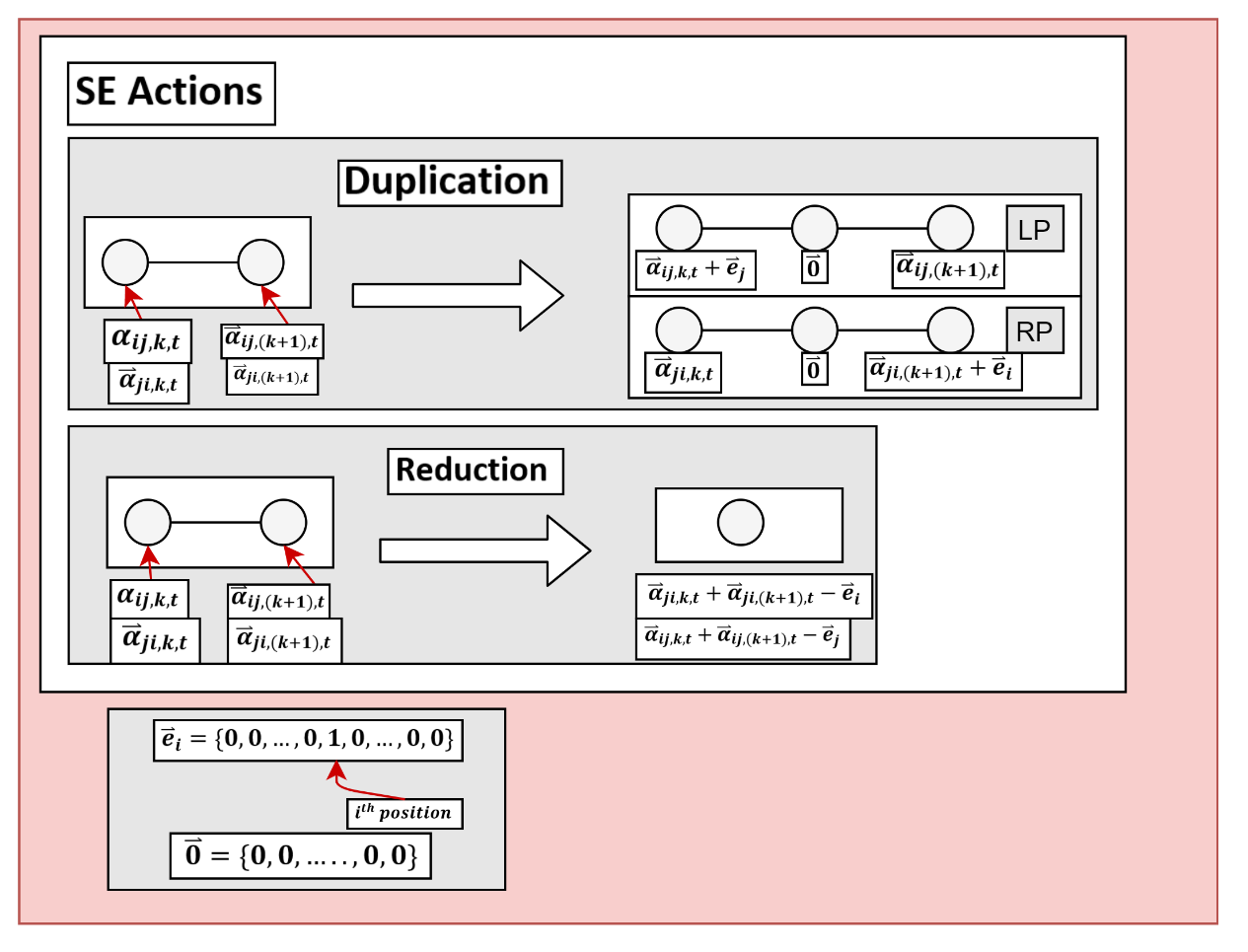
Update rules on Point Particles (PP) (This occurs once for each time step)
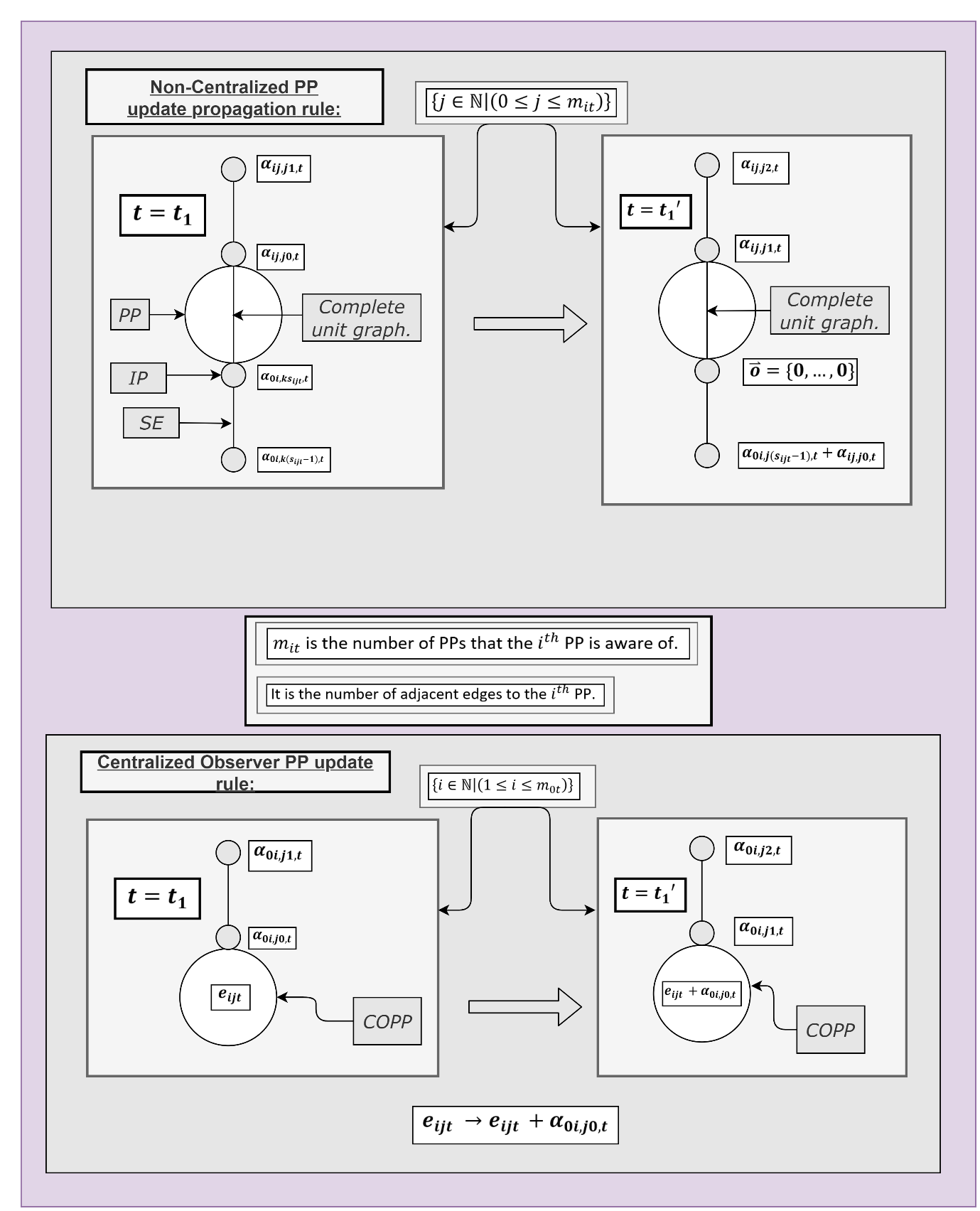
It is important to say, although it may be apparent, that in these diagrams an individual IP or IE describes a set of IP or IEs and not necessarily and individual one.
Additional: PP Splitting (This occurs once for each PP for each time step)
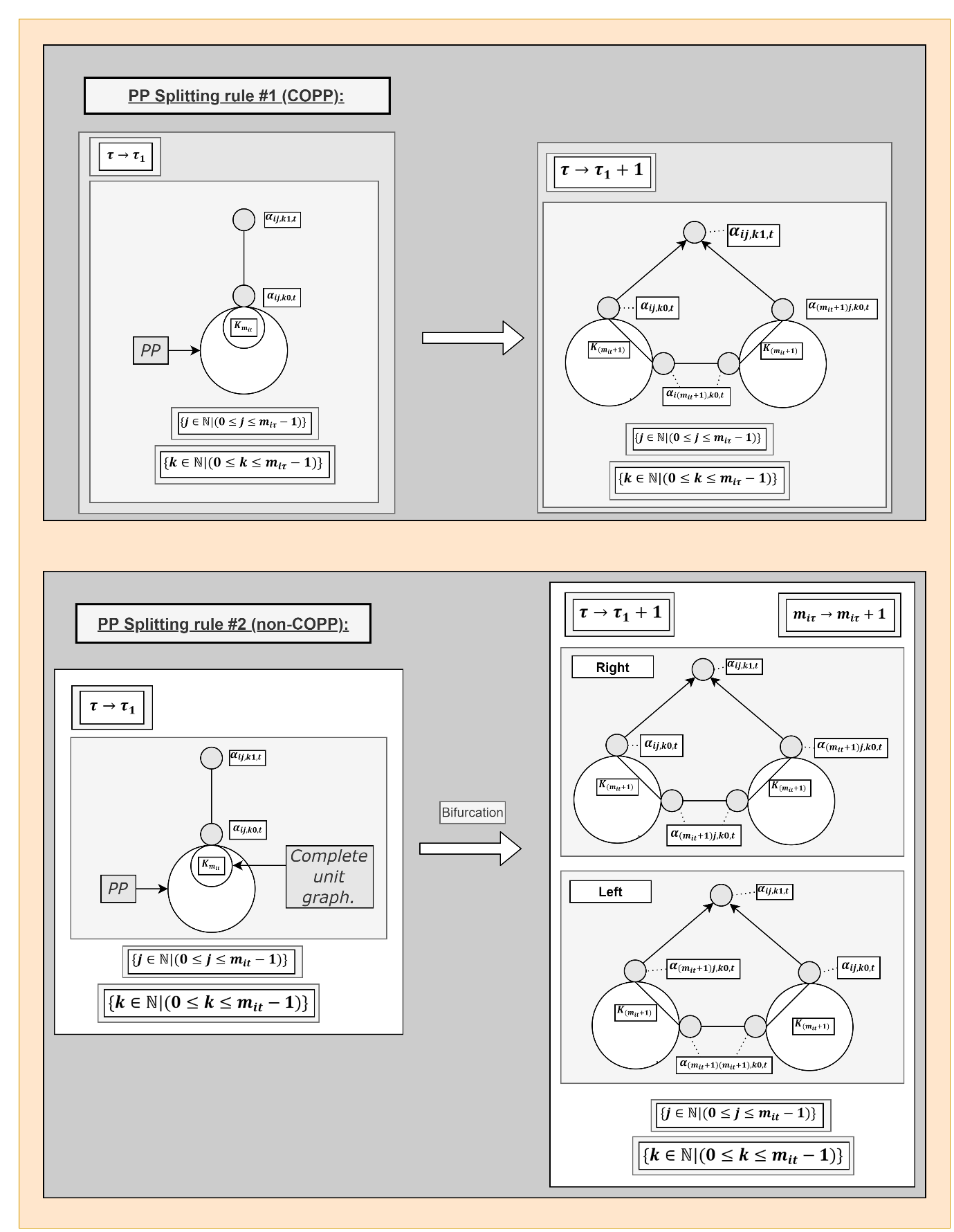
Case 2: Splitting, merging and information propagation.
SE actions:

In the last data structure, the elements of the IPs were represented by arrays of constant size and so superposition was allowed through simple vector addition. Now in the most general case we replace our arrays with abstract undefined data structures. Duplication adds an additional SE to the structure of the network, as well as the information required to indicate that a duplication occurred at this point which propagates along both directions of the IE at one a rate of one space element per time step. The addition sign in the reduction action implies that the data structures are combined in some way to preserve the information of the system much like with the vector addition. Is it possible for a reduction to occur that brings together two separate IPs that have a different number of entries of PPs? How does this affect the data structure?
PP actions:
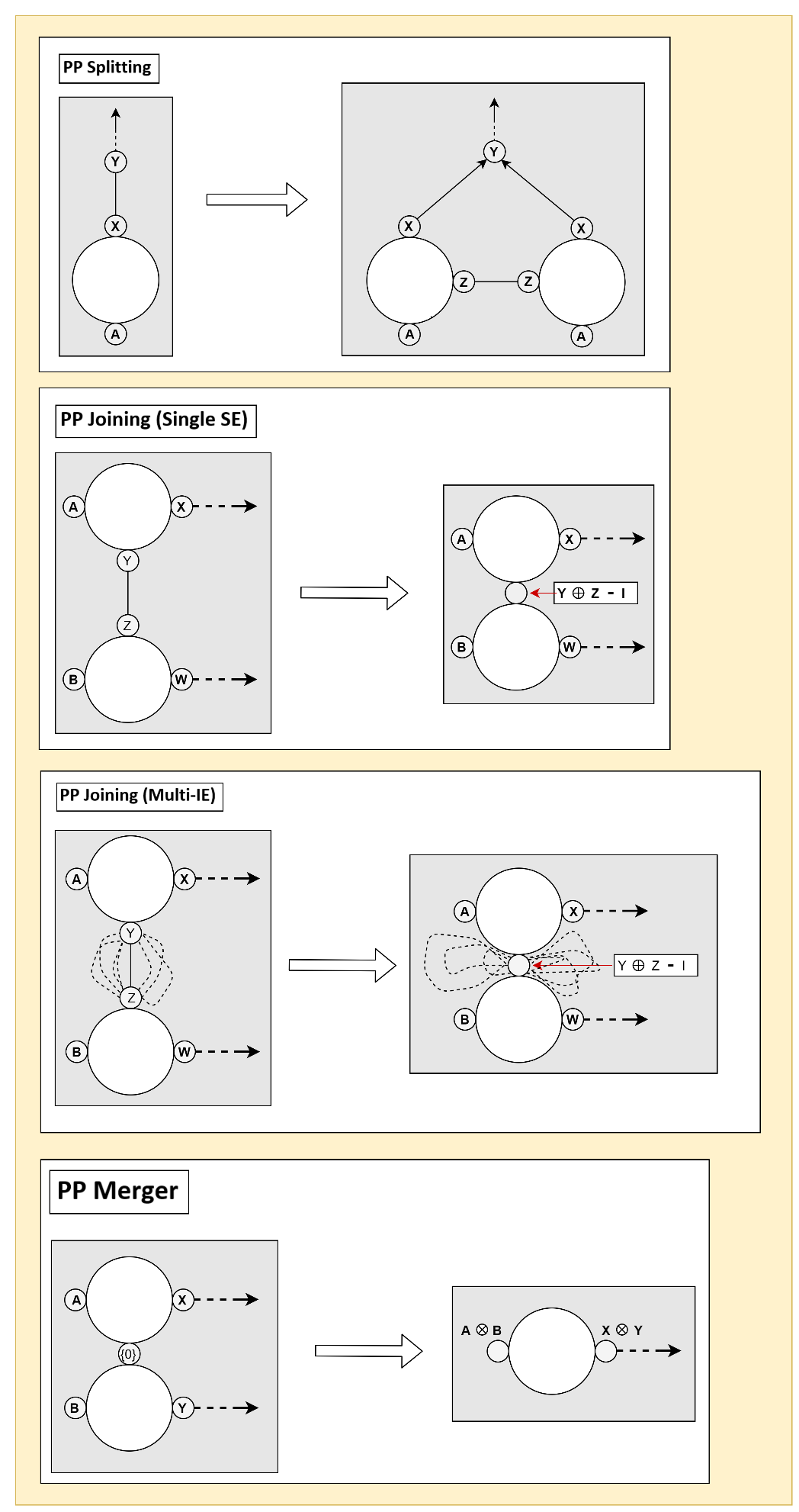
Note: It is important to note that for all diagrams of PP actions, when the symbol for the data structure on the IP is in bold it is referring to a set of adjacent IPs and therefore a set of adjacent data structures.
The main problem comes from PP actions. These lead to the possible consequence of arrays of different lengths combining. The circular plus and circular times symbols represent the action of either combining the information on an IP or combining the information on a PP respectively.
PP Splitting - PP splitting is a ‘cloning of PPs’ where all incident IPs are unchanged under the operation but a replica/mirror image of a PP is created under that operation. PP splitting causes Propagating Structural Bifurcations that transmit the information of the split.
PP Joining - This is where all SEs in an IE between two PPs all reduce in the same time step. This then results in two separate PPs, defined by the differences in their adjacent information and IEs, being separated in a space that has different proportions to that of the SEs. There may well be self IE loops, both between the pair of PPs and within a single PP as well. This leads to the possibility an internal PP space of CPPNs, (Connected Point Particle Networks). CPPNs appear as non-volumous in the external IE space but of a specific shape in the internal CPPN space. This means that a CPPN may appear as a PP but exhibit different properties depending on the internal structure of the CPPN in the CPPN space. There may well be internal IEs between connected PPs in the same CPPN and this will lead to a ‘shape’ of the CPPN in its own internal space. PPs being joined and not separated by any SEs allows for PPs themselves to form structures and have a geometry, separate to that of the geometry of the space they exist within. A sort of internal geometry. It is interesting to consider what interactions or relations may occur between the geometry of a CPPN in it’s internal space and the properties and behaviours it exhibits as a particle in the external space. Could there be a relationship between the number of joined PPs in a CPPN and the mass of the CPPN in the external space? Can stable states of CPPN emerge and evolve? Perhaps through quantum observation. Forcing the possible states into a subset and repeating, until you are in a specific state, or set of states that are constrained in their parameters and behaviours.
PP Splitting in CPPNs - When a normal split update rule is applied in a CPPN there are three possible ways to imagine them.
Internal PP splitting: One is as a single constituent PP in a CPPN and having all external and internal IPs and their connections be ‘cloned’ or mirrored, with all propagating bifurcations included. This will effect the PP number of the CPPN and the interconnection. It will never lead to splitting the CPPN as internal connections are always conserved in this update operation.
PP Unjoining: The second is by recreating a separation of one SE between two PPs. This could have the effect of splitting CPPNs in two if it occurred on a unique IP bridge between two subgraphs of the CPPN. This could have the effect of ‘severing the CPPN’ into two pieces with the possibility of internal geometry immediately affecting external geometry. (If there are internal IEs already between the two PPs that will immediately effect the distance metric, this may have the effect of making two particles become two highly separated particles instantaneously.)

- CPPN Splitting: This is where the entire CPPN acts as a PP and clones it’s entire structure creating PSBs on all cloning IPs. For this to make any sense you would need to make every PP in the CPPN to create a mirror of itself using a complete symmetric unit bipartite graph. Every PP in each CPPN is separated to every other PP in the other CPPN by at minimum an IE of one SE. This seems less emergent and also requires simultaneous evolution of a large number of objects. This is not necessarily impossible however does not feel all that emergent or simple. I would argue that this rule is not emergent from the philosophical first principle.
PP Merger - This is where two PPs separated by an empty IE gap merge to form one PP with some kind of mixing operation performed on all of the internal and external IP connections. This operation must in some sense preserve connections. There is a question here, does one PP know where connections of the IPs from the other PP come from. How do they share information. Two PPs may appear as distinct while they are actually identical. This may lead to separate IE end points eventually merging to form the same endpoint. There may be IEs between any two PPs, and those IEs may be many with multiple endpoints on the same PP. If self loops are able to occur on an individual PP where the IE end points are not required to be identical, I can envisage a scenario where the locations of these endpoints on the same PP have some form of internal space dynamics. These dynamics would correspond to endpoints of self loop IEs on the ‘boundary’ of the dimensions of the PP. Could this be a further deeper space. Also could this imply that the self IE loops create a space or geometry in three dimensions that creates a dynamics in two dimensions on the surface boundary of the PP. That the graphs with representations in n and n+1 dimensions are isomorphic. So two possibilities occur for merging, either information of PPs and their locations are shared and connected in some way (IPs are shared amongst IE going to the same PP), or there is some other mixing effect. It may be that the information of which PP an IE is directed towards becomes confused as the IEs have no way of knowing which IE represents which PP and vice versa, unless they share that information, which they likely do, and so perhaps one way of a merger occurring is simply the multiway system of all possible combinations of IE end IP mixing. I’ll have to give some thought to that one.
Propagating Structural Bifurcation (PSB) Actions:
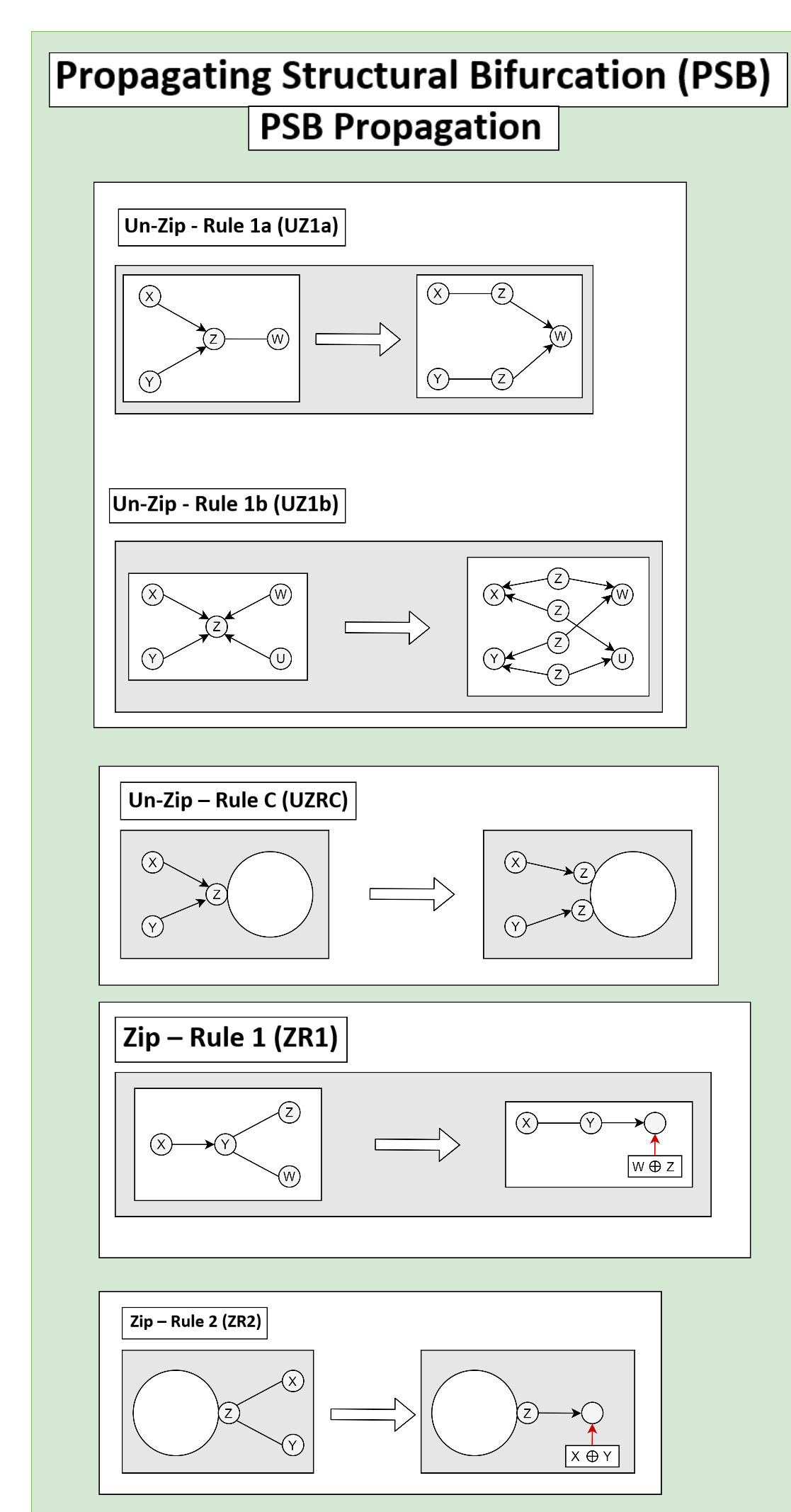
These transmit the information of whether a PP has split or merged across the external, and internal space. The first set of rules were the rules that made the most sense since it satisfies the condition of transferring information between elements one element for each time step.
Here bifurcations act along all IEs that are incident to a split or a merger. This bifurcation then propagates through the system cloning the information as it goes. We then have multi-IEs occurring when two PPs that get split are joined. Then if they merge they either stay as multi-IEs to eventually fully reduce, or some type of zipping effect occurs, ‘weaving’ or superimposing the two sets of independently evolving information stores on each IP.
The Zipping rule is another rule where the rules are not uniquely defined since the data structure must become more general to encode of the splitting and merging of PPs. A Zipping rule seems like an unnecessary added dynamic that may not be fully emergent.
UZ1a and UZ1b are two update rules that seem to emerge naturally from PP splitting and allow for the signals of a split to propagate through the system to an observing PP. The arrays will increase in size by one to include the information of the new PP. It may be that causal invariance of the system enforces that the propagation only occurs once for each time step. Also, there may be a connection between the inverse square law of propagating energy (photons) and the trivalent structure emerging out of this phenomena.
For UZ1b it is possible to imagine a situation where multiple reductions bring more than two PSBs together. PSBs always move at one SE per TS and so can never overtake each other, but reductions could possibly make them overlap. This would be unlikely but possible. In this case the connections would be isomorphic to a k-Partite graph with each vertex set of size 2. K2,2 for two colliding PSBs and K2,2,2 for 3 and so on. There would be an intermediary IP between two SEs that would be a clone of the central intersecting IP of the colliding PSBs.
Also when a reduction occurs on a PBS it conserves the direction of propagation. UZC also describes how a PP will separate the IP that correspond to IEs connected to different PPs. This may also occur to IEs stored between the same PP, however this may lead to some ambiguity with the results.
Additional possible rules for PSBs: Here some additional optional rules for PBS propagation. I’m still unsure about which of these is the ‘simplest’, or feels the most emergent from the postulate of the transfer of information across elements.

There is also the question of how this rule set leads to collisions of PSBs conserving IEs. I’m not sure if it will happen for this set of rules.
Another set of rules that could both preserve IE connections and also lead to an inverse square law is the following.

In UZ3 there is the chance that propagating information packets will be forced to fall into one of the other branch, this may lead to something like the inverse square law for photon intensity.
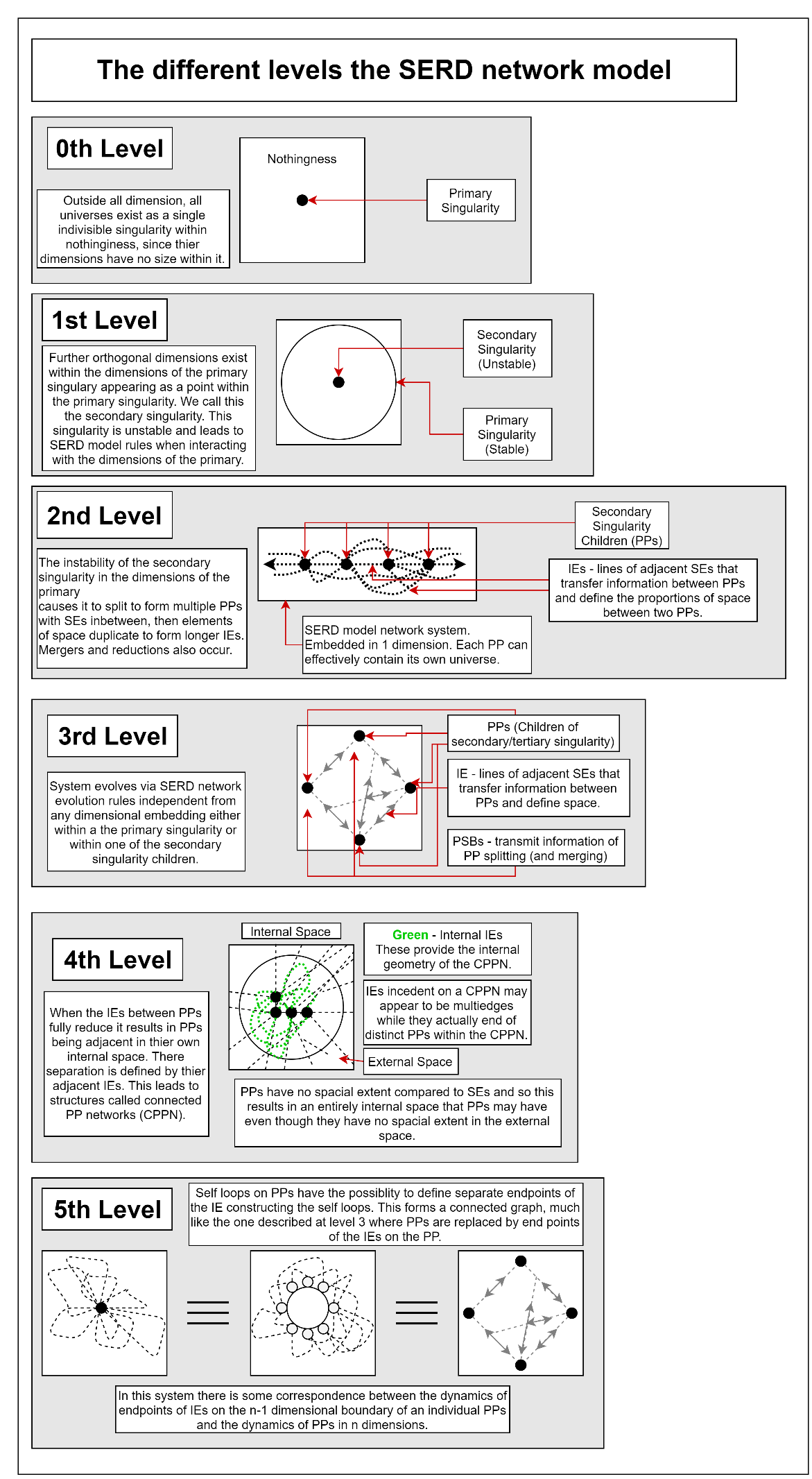
My question is basically this. Do people think there is a chance that this system fits within the wolfram model, is there some representation there, or is there something which makes it incompatible? Or further to that, and perhaps more importantly, is there an obvious aspect of the system described that makes it unphysical?
- I’m aiming to represent the superimposing propagating information as encoded in the hypergraph in some way, I’m not entirely sure how to do that.
- Also, we may have substitution rules that incorporate an arbitrarily large number of elements. For example, PP splitting, where there will be an arbitrarily large number of IEs ending on the PP that will need to be ‘cloned’ under PP splitting.
- This may result from (and I hope it does) from the causal structure of the system, but the postulate of information transfer, that an element may only pass information that it knows about to its nearest neighbors in one timestep. This seems deterministic, however may simply emerge out of the causal structure of the system.
Also, if anyone has any ideas of what a suitable general data structure could be for a system like this feel free to get in touch and we could have a chat about it. I’m open to suggestions. I’m simply working to try and put it all together and understand this system that seems to emerge out of some fundamental philosophical concepts. I will continue my research on this, I have a number of areas/physical comparisons that I want to explore further as well as some evidence of physical comparability already. If you would like to let me know what you think of these rules or the philosophical motivation described in my earlier post, please feel free to email me directly or leave a comment. Tommy
Email: tommyleonwood@gmail.com
Additional material. Introductory Mathematica notebook and code repository: https://drive.google.com/file/d/1sbrTDLfYQLK1Ho2m6UJ_d9lZy3Sdg408/view?usp=sharing Youtube series: Video 1: A qualitative introduction - https://youtu.be/35MkO2p7yV8
Video 2: An introduction to the code and some results - https://youtu.be/BPQi0WfGMRs
Video 3: Demonstration of compatibility with Newton's laws - https://youtu.be/KZEO-ZHGgPM
Video 4.1: Evidence of constancy of speed of light in all inertial reference frames - Part 1 - https://youtu.be/yr6hwaz8Hkk
Video 4.2: Evidence of constancy of speed of light in all inertial reference frames - Part 2 - https://youtu.be/rhwWCyaJvDY
Please take a look at my earlier post from early July where I shared my Mathematica document with all of my source code as well as some youtube videos explaining the system, implementation and physical comparisons.
https://community.wolfram.com/groups/-/m/t/2589079